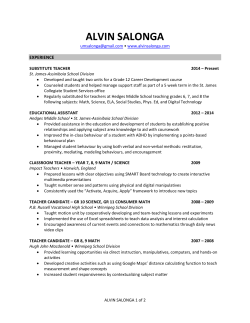
CLINICAL PRACTICE CHANGE - Diagnostic Services Manitoba
May 6, 2015 aPTT Testing Availability and Other Coagulation Testing Changes The following elaborates on testing changes for: 1. aPTT Testing 2. Introduction of DIC (Disseminated Intravascular Coagulation) Screen Panel 3. Reportable PT (Prothrombin Time) 1. aPTT testing: The suboptimal utilization of aPTT test has been identified as a prevalent problem across all health regions in Manitoba. As part of "Choosing Wisely" initiative, Diagnostic Services Manitoba (DSM) Hematology discipline has consulted with clinical experts and stakeholders to help provide direction relating to aPTT test. The following statements address the rationale and recommendations for aPTT test in Manitoba: aPTT should not be used as a screening test for coagulation disorders in patients with no personal or family bleeding history or are otherwise asymptomatic. aPTT test has very limited utility as a diagnostic test for coagulation disorders, since a normal value does not rule out the presence of important disorders of hemostasis, and false positives are commonly encountered. Patients suspected of having defects of hemostasis based on their clinical history should be referred to clinical hematology for comprehensive assessment. Current use of aPTT should be limited to monitoring therapy with unfractionated heparin, which is a high-risk medication that requires continuous monitoring and dose adjustment. For safe alternatives to unfractionated heparin, please refer to separate memo issued in 2013 and consult local pharmacist, hematologist, cardiologist or nephrologist. aPTT as a test will be progressively phased out from DSM sites that do not use unfractionated heparin regularly. The test will continue to be available at the larger hub sites and labs in Winnipeg. Blood samples from small sites where aPTT tests are discontinued, can be shipped to nearby hub sites if aPTT testing is deemed necessary after consultation with the hematopathologist on hemostasis service during business hours or on-call hematopathologist after hours. The rotating schedules and hematopathologists’ contact information are available at all DSM hematology labs. The unavailability of aPTT test at smaller sites should have little impact on clinical practice. DSM plans to discontinue aPTT test in some small sites as of June 01, 2015. Sites that will continue to provide aPTT test are as follows: WRHA Labs Selkirk Brandon Dauphin Thompson Steinbach Winkler The Pas Portage Flin Flon -1dsmanitoba.ca Suite 1502 – 155 Carlton Street Winnipeg, Manitoba R3C 3H8 155, Rue Carlton, suite 1502 Winnipeg (Manitoba) R3C 3H8 T 204.926.8005 1.866.320.8796 – Toll-free Manitoba only F 204.940.1761 2. Introduction of DIC (Disseminated intravascular coagulation) Screen Panel: DIC is a common acquired coagulation disorder resulting from excessive activation of the coagulation system and resulting in disseminated microvascular thrombi, usually due to massive tissue injury, sepsis, or certain pregnancy complications. The key laboratory findings are elevated D-dimers or fibrinogen degradation product (FDP), prolonged PT and/or PTT, and decreased or decreasing platelets and fibrinogen. DIC screen panel includes D-dimer, prothrombin time (PT), complete blood count (CBC), and Clauss fibrinogen. The panel of tests is used to help diagnose overt acute DIC in patients with an underlying disorder known to cause DIC and/or with clinical suspicion of DIC. Of note, the tests are not, however, specific for DIC. Results must be reviewed in relation to the clinical situation. It is important to note that these tests can be normal in a substantial percentage of DIC cases. The clinical features and laboratory findings in chronic DIC can be much more subtle than with acute DIC. Repeat testing may be needed to show the development of abnormal results over time. Last but not the least, the newly introduced DIC basic screen is different from the sophisticated DIC profile testing under special hemostasis, which requires consult and approval from clinical hematologist or hematopathologists. 3. Reportable PT (prothrombin time): The World Health Organization along with the International Committee on Thrombosis and Haemostasis recommend that reporting of PT results for patients on oral anticoagulant therapy include the use of INR (International Normalized Ratio) values. Reported INR results are independent of the reagents and methods used and are specifically intended for assessing patients stabilized on long-term oral anticoagulant therapy. INR is the result of the patient PT/mean normal PT, exponentially equalized by the ISI (International Sensitivity Index of the reagent/instrument combination). In short, An INR should only be used to determine the appropriate dose of an anticoagulant. Historically, PT has been most frequently ordered in patients on warfarin therapy, as a result only INR is reported at DSM labs when PT is ordered. In recognition that INR is not suitable for assessing bleeding risk in certain medical conditions such as liver disease, sepsis, inherited bleeding disorders or therapy with new oral anticoagulants, both PT and INR will be reported in the future when PT and/or INR are ordered. If you have any questions or concerns regarding these new changes or you would like to have a teleconference for in-depth discussion, please contact one of the following: Dr. Charles Musuka, 204‐237‐2471 (o), 204‐935‐2168 (pager), cmusuka@dsmanitoba.ca Dr. Ping Sun, 204‐258‐1114 (o), 204‐935‐2908 (pager), psun@dsmanitoba.caDr. Carmen Morales, 204-787-4682 (o) 204-932-0203 (pager), cmorales@dsmanitoba.ca -2dsmanitoba.ca Suite 1502 – 155 Carlton Street Winnipeg, Manitoba R3C 3H8 155, Rue Carlton, suite 1502 Winnipeg (Manitoba) R3C 3H8 T 204.926.8005 1.866.320.8796 – Toll-free Manitoba only F 204.940.1761
© Copyright 2025










